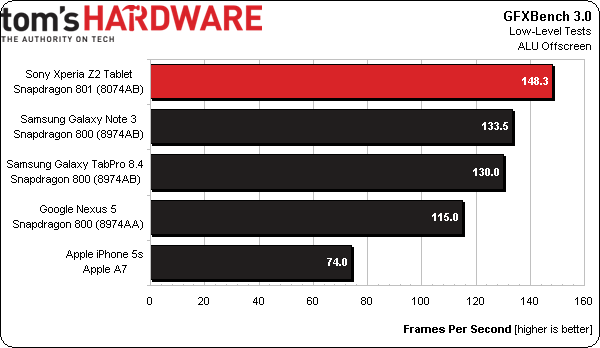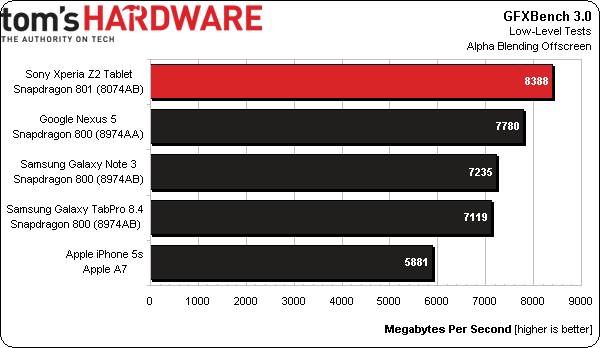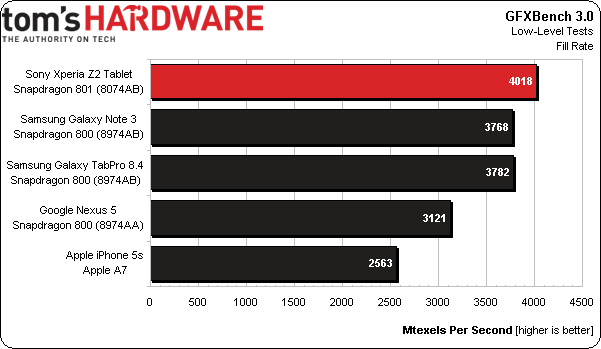Qualcomm Snapdragon 801: Performance Previewed
Snapdragon 801, the recently-announced update to the Snapdragon 800, shares some of the same SKUs as Snapdragon 800. So, how do you tell the difference? We break down the family and introduce you to the first benchmarks of Sony's Xperia Z2 tablet, too.
GFXBench 3.0: ALU, Alpha Blending, And Fillrate
ALU 1080p Off-Screen
Reminiscent of demoscene “progs” from the '90s, this ALU test measures pure shader compete performance by rendering a simple scene consisting of a complex shader and a single full-screen quad.
The great thing about GFXBench's low-level tests is that they more effectively isolate subsystem performance. In this case, we're shining the spotlight on shaders, without the impact of hobbled memory bandwidth. Thus, Qualcomm's Snapdragon 801 takes first place. Its 578 MHz Adreno 330 beats out the Galaxy Note 3’s 550 MHz by 11%. Both Snapdragon 800 -AB devices achieve very similar scores. The Nexus 5, with its Snapdragon 800 -AA, takes the second-to-last spot, while the iPhone 5s languishes in last place.
Alpha Blending Off-Screen
In these days of hardware-accelerated UIs, extensive particle systems, and render-to-texture effects, alpha blending performance is very important. In fact, it can mean the difference between a smooth user experience and a stuttering nightmare. This test renders semi-transparent quads using high-resolution, uncompressed textures to strain the GPU.
The trend repeats itself as the Xperia Z2’s Snapdragon 801 grasps the top spot by more than seven percent over Google's Nexus 5 and its Snapdragon 800. Strangely, the two Samsung devices equipped with the faster Snapdragon 800 -AB take third and fourth place. TouchWiz is probably to blame here, stealing precious alpha bandwidth to draw its overlays.
Fill Rate Off-Screen
This test measures texturing performance by rendering four layers of compressed textures simultaneously.
And there it is, folks: the Sony Xperia Z2 tablet has the highest fill rate score of the devices tested. No other benchmark so clearly illustrates the performance bump that Snapdragon 801 offers. The two Snapdragon 800 -AB-based devices take second and third place, tying almost exactly, per their comparable clock rates and SoCs.
Get Tom's Hardware's best news and in-depth reviews, straight to your inbox.
Current page: GFXBench 3.0: ALU, Alpha Blending, And Fillrate
Prev Page GFXBench 3.0: Manhattan And T-Rex Next Page So, Is 801 A Snappier-Dragon?-
Wisecracker A Temash APU and Atom SoCs would make a great cross-platform comparison, here.Reply
The 'Droid Heads would love to see some Tegra 3/4 action, too. -
MANOFKRYPTONAK I really am looking forward to the showdown between the A7/A8, Tegra4/K1. and Intel "what is the name of the chip in the nexus 8?". I hoping to see a worthy $500 upgrade.Reply -
anthony8989 Great article - very informative. Sorry if it's off-topic, but the HTC One (M7 2013) uses an APQ8064T. Did Qualcomm change the meaning of the second numeral from Snapdragon 600 to 80x? The HTC One M7 employs a modem yet now the second numeral being 0 indicates no modem. Or does the device substitute another modem off the SoC? Also what does the "T" suffix mean? :)Reply
EDIT: I realized APQ also indicates no modem so I'll just assume that they supplied an off-SoC modem for the device. Still would like to know what "T"stands for. -
rohitbaran Isn't Tegra K1 (aka Logan) having something else? Project Denver CPU was supposed to be part of Parker SoC as per nVidia's 2013 Tegra roadmap, unless I am missing something.Reply -
edlivian So if you already have a device with a snapdragon 800 you should hold off for a real improvement, like snapdragon 1000 or 1k or whatever marketing jibberish they want to name it.Reply -
edlivian So if you already have a device with a snapdragon 800 you should hold off for a real improvement, like snapdragon 1000 or 1k or whatever marketing jibberish they want to name it.Reply -
Vistouf From Wikipedia :"SKU refers to a stock-keeping unit, a unique identifier for each distinct product and service that can be purchased in business."Reply -
PapaCrazy They compared two different manufacturers devices from two generations in order to extrapolate something about the chip? Huh? What about differences in hardware implementation, software, memory, and all the other things that can independently effect performance? Would have been much better to wait and have more comparable devices to test.Reply


